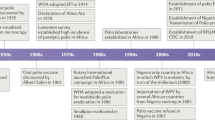Summary
In 1988 the 41th World Health Assembly declared polio to be worldwide eradicated until the year 2000. Although this ambitious aim could not be reached completely, the yearly worldwide incidence was reduced by 99% and three WHO-Regions were declared polio-free (Americans, West Pacific, Europe). To maintain this status the following measures have to be carried out: polio vaccination, enterovirus surveillance, AFP-surveillance, quality control of laboratories and notification of labs keeping stocks of polio wildvirus. Especially after the Second World War Austria faced severe polio epidemics and thus general and free of charge polio vaccination for children and young adults up to 21 years was started in winter 1961/62 by the Austrian Ministry of Health (MoH). Immediately the yearly incidence dropped from 3.65/100.000 (n = 292) in 1961 to 0.1/100.000 (n = 8) in 1962. Since 1998 all mandatory national measures according the WHO polio eradication programme have been performed. Despite the worldwide success of the programme there are currently still four countries with endemic polio and since November 2006 eleven further countries have faced epidemics due to imported cases. Therefore the 60th World Health Assembly in 2007 again pointed to the threat of failing worldwide polio eradication. Currently the Global Polio Eradication Initiative (GPEI) works intensively with the concerned countries to fight against this development.
Zusammenfassung
Die WHO hat anlässlich ihrer 41. Vollversammlung im Jahr 1988 das Ziel formuliert, die Poliomyelitis bis zum Jahr 2000 weltweit zu eliminieren. Dieses Ziel wurde zwar nicht vollständig erreicht, aber es konnte die weltweite jährliche Inzidenz um 99% reduziert werden und drei WHO-Regionen (Amerika, Westpazifik, Europa) wurden für poliofrei erklärt. Um diesen Status zu erhalten, sind folgende Maßnahmen regelmäßig durchzuführen: Polio-Durchimpfung, Enterovirus-Überwachung, AFP-Surveillance, Labor-Qualitätskontrolle und Notifikation aller Labors, die Poliovirus lagern. Österreich war insbesondere in der Nachkriegszeit von schweren Polio-Epidemien betroffen und führte im Impfwinter 1961/62 als eines der ersten Länder weltweit die flächendeckende und kostenlose Oral-Polioimpfung für Kinder, Jugendliche und Erwachsene bis zum 21. LJ ein, was sich unmittelbar in drastisch reduzierter jährlicher Inzidenz (I) niederschlug (1961: n = 292; I: 3.65/100.000; 1962: n = 8; I: 0.1/100.000). Der letzte Poliofall trat im Jahr 1980 auf. Seit 1998 werden zusätzlich alle notwendigen nationalen Maßnahmen des Polio-Eradikationsprogrammes vollständig umgesetzt. Trotz der weltweiten Erfolge ist Polio noch in vier Ländern endemisch, und es traten zusätzlich seit November 2006 in elf Ländern Ausbrüche nach Neu-Einschleppung auf. Die WHO wies daher bei der 60. World Health Assembly 2007 neuerlich auf die immanente Gefährdung des Polio-Eradikationsprogrammes hin und arbeitet im Rahmen der Global Polio Eradication Initiative (GPEI) intensiv mit den betroffenen Ländern an spezifischen Bekämpfungsmaßnahmen.
Similar content being viewed by others
Literatur
WHO (2007) Poliomyelitis – fact sheet. www.who.int/mediacentre/factsheets/fs114/en
World Health Organisation (1993) Global Eradication of Poliomyelitis by the Year 2000. 41th World Health Assembly, Geneva, Switzerland Resolution 41.28 In: Handbook of resolutions and decisions of the World Health Assembly and the Executive Board, Volume III, 3rd Edition (1985–1992). WHO, Geneva
Global Polio Eradication Initiative (GPEI) (2007). www.polioeradication.org/casecount.asp
WHO (2002) Europe achieves historical milestone as region is declared polio-free. www.who.int/mediacentre/news/releases/releaseeuro02/en/index.html
Epidemiegesetz 1950, BGBl Nr 186/1950 idgF
Grubmueller J, Holkup H (1956) Outbreak of poliomyelitis in Lower Austria. Wien Klin Wochenschr 68: 1017–1019
Bundesministerium für Soziale Verwaltung (1968) Schluckimpfung gegen Kinderlähmung in Österreich – Versuch einer Bilanz. Europa Verlag
Bundesgesetz über öffentliche Schutzimpfungen gegen Kinderlähmung, BGBl Nr 244/1960 idgF
Bundesgesetz, mit dem das Bundesgesetz über öffentliche Schutzimpfungen gegen übertragbare Kinderlähmung aufgehoben wird, BGBl Nr 93/2002
WHO Collaborative Study Group (1982) The relationship between persisting spinal paralysis and poliomyelitis vaccine – results of a ten year enquiry. Bull World Health Organ 60: 231–242
Empfehlungen des Obersten Sanitätsrates (2007) Impfplan 2007 Österreich. www.bmgfj.gv.at/cms/site/attachments/1/4/0/CH0016/CMS1038913010412/impfplan_2007_aktuell.pdf
Samba E, Nkrumah F, Leke R (2004) Getting polio eradication back to track in Nigeria. N Engl J Med 350: 645–646
Robert-Koch-Institut (2006) Zum Welt-Poliomyelitistag 2006: Globale Eradikation erfordert weiterhin intensive Bemühungen. Epidemiol Bull 10: 371–372. www.rki.de/cln_049/nn_196658/DE/Content/Infekt/EpidBull/Archiv/2006/43__06,templateId=raw,property=publicationFile.pdf/43_06.pdf
WHO (2003) Global Polio Eradication Initiative – Strategic Plan 2004–2008. www.polioeradication.org
WHO (2007) Poliomyelitis: mechanism for management of potential risks to eradication (EB120.R1). Report of the Executive Board on its 118th, 119th, and 120th session. www.who.int/gb/ebwha/pdf_files/WHA60/A60_2-en.pdf
WHO (2006) Meeting Advisory Committee on Polio Eradication. Weekly Epidemiological Report 81: 465–468
Financial Requirements of the Global Polio Eradication Initiative (FRRs). www.polioeradication.org/fundingbackground.asp
Global Polio Eradication (2007) Polio News 29: 8
Arita I (2006) Public health. Is polio eradication realistic? Science 312: 852–854
Thompson KM, Duintjer Tebbens RJ (2007) Eradication versus control of poliomyelitis: an economic analysis. Lancet 369: 1363–1371
Halbich-Zankl H, Sagl M, Strauss R (2000) Ausrottung der Poliomyelitis: was tragen wir in Österreich zum Aktionsplan der WHO bei? Mitt Sanit Verwalt 10: 3–8
Wewalka G (2007) Jahresbericht 2005 und 2006 der Nationalen Referenzzentrale für Polio (NRZP). Mitt Sanit Verwalt 4(108): 20–22
Author information
Authors and Affiliations
Corresponding author
Rights and permissions
About this article
Cite this article
Strauss, R., Sagl, M., Wewalka, G. et al. WHO-Eradikationsprogramm für Poliomyelitis: Status quo und Umsetzung in Österreich. Wien Klin Wochenschr 120, 210–216 (2008). https://doi.org/10.1007/s00508-008-0956-y
Received:
Accepted:
Published:
Issue Date:
DOI: https://doi.org/10.1007/s00508-008-0956-y




